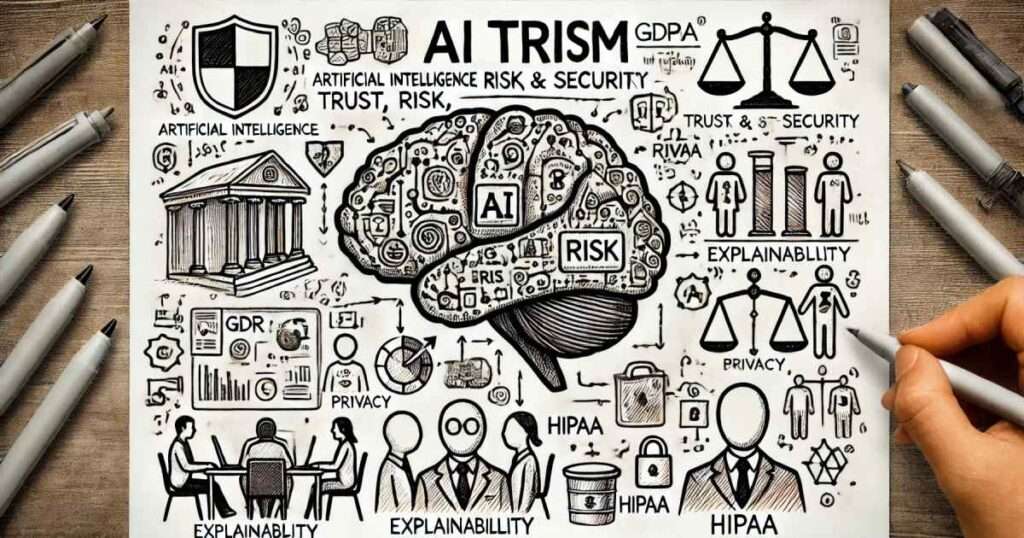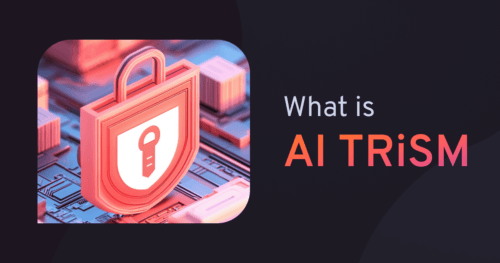What is AI TRiSM and Why Does It Matter in AI Models?
As organizations increasingly adopt Generative AI and AI Copilots to drive business transformation, security, user privacy, and trustworthiness are top of mind. For organizations planning to deploy Generative AI and AI Copilot, it is critical to address these concerns upfront.
Addressing these issues proactively will foster trust in AI, facilitate AI adoption, mitigate risks, and ensure compliance with regulations. For the first time, Gartner introduced the AI TRiSM framework to help organizations develop a solid AI strategy. In this article, we will explore the AI TRiSM framework and how organizations can leverage it to achieve ROI with AI investments.
AI TRiSM, an acronym for Artificial Intelligence Trust, Risk, and Security Management, is a concept Gartner first introduced. AI TRiSM is a framework to ensure AI models and applications are reliable, fair, private, and trustworthy, and based on solid ethical principles. The AI TRiSM framework will help organizations manage the risks of AI, comply with regulations, and contribute to the evolution of responsible AI.
Gartner research forecasts that by 2026, organizations that operationalize transparency, trust, and security in their AI initiatives will see a 50% increase in both AI adoption and business results.
Real-world Risks and Regulatory Pressures
As organizations deploy Agentic AI in highly regulated industries, they face significant risks and regulatory challenges. The risks of hallucinations and embedded biases in AI are heightened in these environments, where small inaccuracies in generated content can lead to safety and compliance failures. Ethical considerations are paramount in these environments, as organizations must ensure that their AI systems operate fairly and transparently.
These hallucinations can be driven by biased data or flawed AI algorithms and can have serious consequences, particularly in sensitive sectors such as healthcare, finance, and law where accuracy and trust are essential.
Additionally, user privacy is a key challenge, as AI applications process and interact with large amounts of user data. One major concern is the risk of data leaks, where sensitive information or confidential data can be exposed.
Also, there are concerns regarding unauthorized access and data usage, as well as the need for transparency in how data is being used and accessed. For organizations operating in highly regulated environments, strong security and compliance with data protection laws such as GDPR and HIPAA underscore the need for responsible AI solutions.
Trust and security are paramount for any organization looking to leverage an AI Copilot, as systems must be both accurate and ethical to mitigate risks and build confidence among users and stakeholders.

Key Components of the AI TRiSM Framework
Three critical components of the AI TRiSM framework are explainability and model monitoring, AI security and privacy controls as well as model operations. Together, these components ensure that AI models and applications offer transparency in decision-making and safeguard sensitive data against evolving threats, fostering trust and confidence in AI deployments.
However, organizations must also be aware of AI TRiSM challenges, such as data privacy and ethical concerns, which require strict governance frameworks.
1. Explainability and Model Monitoring
Explainability ensures that the decisions made by AI are transparent and understandable to developers, business leaders, and more. An explainable AI system builds trust and enhances accountability in its outputs, allowing users to identify any potential biases and ensure ethical and responsible use in highly regulated environments such as government, healthcare, and more.
On a similar note, model monitoring involves tracking the real-time performance of AI models to detect performance issues, data quality issues, or any drift from expected behavior. Models can degrade over time due to changes in real-world data, so model monitoring can detect and help prevent performance degradation.
By evaluating various metrics such as accuracy, fairness, and reliability, model monitoring helps ensure that the AI model is stable. Together, explainability and model monitoring enable organizations to deploy AI confidently while staying aligned with business objectives and ethical and regulatory standards.
2. AI Security and Privacy Controls
Another key component of the AI TRiSM framework is AI security and privacy controls. By implementing robust encryption, access control measures, and conducting regular vulnerability assessments, organizations can enhance Generative AI security, safeguard sensitive user information, and protect against cyber threats.
This includes prioritizing LLM security to address AI specific vulnerabilities associated with large language models, thereby ensuring these models are safeguarded against unauthorized access and manipulation.
AI runtime inspection plays a critical role in this process by continuously monitoring model behavior during execution to detect anomalies, policy violations, or malicious activity in real time. This proactive layer of defense ensures that models not only function as intended but also remain secure in dynamic environments.
Privacy controls focus on regulator compliance with stringent data protection regulations, such as GDPR and CCPA, by anonymizing personally identifiable information (PII) and implementing secure data handling practices. By integrating advanced AI security and privacy measures, organizations can ensure their AI remains reliable and compliant with the latest security management standards and regulations.
3. Model Operations (ModelOps)
Model Operations (ModelOps) is a critical component of the AI TRiSM framework, focusing on the comprehensive management of AI models throughout their lifecycle. This involves creating robust processes and systems for deploying, monitoring, and maintaining AI models in production environments. Effective ModelOps ensures that AI models are reliable, efficient, and scalable, continuing to deliver accurate results over time.
ModelOps encompasses several key activities:
- Model Deployment: This involves deploying AI models in production environments, ensuring they are properly configured and seamlessly integrated with other systems. Proper deployment is crucial for the models to function effectively and deliver the expected outcomes.
- Model Monitoring: Continuous monitoring of AI models in production is essential to track their performance and identify potential issues. By keeping a close eye on the models, organizations can detect anomalies, performance degradation, or any drift from expected behavior, ensuring the models remain accurate and reliable.
- Model Maintenance: Over time, AI models may require updates and refinements to maintain their accuracy and effectiveness. Regular maintenance activities, such as retraining models with new data and fine-tuning algorithms, help keep the models up-to-date and aligned with the evolving data landscape.
- Model Governance: Establishing robust policies and procedures for managing AI models is a cornerstone of ModelOps. This includes comprehensive data management practices, stringent security measures, and adherence to compliance requirements. Effective model governance ensures that AI models operate within the defined ethical and regulatory boundaries, fostering trust and reliability.
By implementing ModelOps, organizations can ensure that their AI models are properly managed and maintained, reducing the risk of errors, bias, and other issues. This, in turn, helps build trust in AI systems and supports the broader adoption of AI technologies. The AI TRiSM framework, with its focus on ModelOps, provides a structured approach to managing the lifecycle of AI models, ensuring they deliver consistent and trustworthy results.
Benefits of Adopting AI TRiSM
In the rapidly evolving landscape of AI, adopting the AI TRiSM framework can help organizations mitigate risks and build trust in their Generative AI and Agentic AI.
1. Enhancing Business Outcomes through Risk Mitigation
By implementing AI TRiSM methodology and proactive risk strategies, businesses can identify vulnerabilities and limitations of their AI models and applications, which can minimize the damage when it fails. Given that one of the cornerstones of AI TRiSM is transparency, organizations adopting the framework can explain AI processes and decisions to stakeholders, building trust in AI and the overall system.
As a result, organizations can be confident that the AI technologies they develop and deploy operate efficiently while maintaining high standards of trust and security management.
2. Building Stakeholder Trust in AI Systems
Adopting AI TRiSM demonstrates a commitment to ethical and responsible AI practices that build stakeholder trust and differentiate organizations in competitive markets.
Through comprehensive data protection measures and rigorous compliance protocols, companies can safeguard sensitive information while maintaining the integrity of their AI systems. The result is a more resilient approach to AI model governance that not only minimizes operational risks but also builds confidence among customers, investors, and regulatory bodies.
Implementation Essentials for Businesses
To effectively navigate the complexities of AI Trust, Risk, and Security Management (AI TRiSM), businesses must prioritize two fundamental strategies: assembling a multidisciplinary team and safeguarding data and model integrity. Here’s how these essentials lay the groundwork for responsible AI implementation:
1. Engaging a Diverse Team for AI TRiSM
Organizations should establish a dedicated team for their AI TRiSM efforts, including members of various backgrounds such as data scientists, cybersecurity specialists, legal professionals, and more. Bringing together diverse viewpoints concerned with different facets of the AI TRiSM will allow organizations to create and implement policies tailored to the organization’s needs.
This team must continuously monitor and evaluate these policies and adjust as needed to address emerging challenges and new regulations. Additionally, the team should establish clear processes on how to respond to incidents or changes in the AI models and systems.
This robust approach ensures that the organization’s AI TRiSM policies are comprehensive, helping to foster increased trust and commitment to responsible AI practices.
2. Prioritizing Data and Model Integrity
Data and model integrity are crucial to the successful implementation of the AI TRiSM. By ensuring the explainability of AI processes and decisions and transparency in machine learning models, and training processes, organizations can better understand their models and data and ensure that AI models and their generated content are accurate and reliable.
Organizations must also assess their data and models for underlying biases that may affect the content that is created. To maintain model and data integrity, organizations should incorporate comprehensive risk management into AI operations, including automated accuracy validation, taking security measures against data manipulation, and staying compliant with privacy and security regulations. With these practices, organizations can implement a robust framework guided by AI TRiSM principles.
Aisera’s TRAPS Framework
Aisera implements the principles of AI TRiSM with its TRAPS framework (trusted, responsible, auditable, private, and secure), setting the standard in ethical AI development and deploying AI models. With a commitment to responsible AI and privacy protection, Aisera adheres to up-to-date ethical and security standards. Aisera is ISO/IEC 27001 and CSA Star Level 1 certified and is also SOC 2, GDPR, HIPAA/BAA, and CCPA compliant it also anonymizes PII information to increase the security and privacy of user data.
Data confidentiality is paramount, and Aisera ensures that customer data remains secure within its environment. Aisera’s Agentic AI anonymizes PII information to ensure data privacy and Aisera does not use your organization’s data to train other models.
Additionally, Aisera is dedicated to enhancing transparency and reducing bias in AI models. We offer a glass-box AI approach, augmented by human-in-the-loop reinforcement training, which allows Aisera to deliver accurate and trusted Agentic AI.
Aisera’s TRAPS framework puts AI TRiSM principles into practice, providing Agentic AI solutions that set the standard for ethical, secure, and responsible AI applications.
Conclusion
As AI Assistants become central to enterprise operations, adopting a comprehensive governance framework like AI TRiSM is essential. By focusing on transparency, explainability, model monitoring, and robust security and privacy controls, AI TRiSM helps organizations mitigate AI risks and ensure that models remain reliable, fair, and compliant with evolving laws.
By implementing a robust governance framework, organizations not only build trust among stakeholders but also maintain the security of their data while enhancing the overall performance of their AI solutions. Businesses can confidently navigate the complex and evolving landscape of AI and unlock the full potential of their AI investments by leveraging frameworks like AI TRiSM.
Ready to experience the power of responsible AI? Book your free AI demo today and see how Aisera can transform your operations with trust and transparency.


